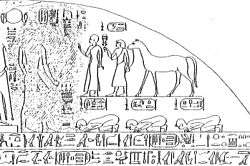Peftjauawybast
Peftjauawybast[2][1]:318–9 or Peftjaubast was an ancient Egyptian ruler ("king") of Herakleopolis Magna during the 25th Dynasty.
| Peftjauawybast | ||||||||||||||||||||||||||||||||||||||||||||
|---|---|---|---|---|---|---|---|---|---|---|---|---|---|---|---|---|---|---|---|---|---|---|---|---|---|---|---|---|---|---|---|---|---|---|---|---|---|---|---|---|---|---|---|---|
| Peftjaubast | ||||||||||||||||||||||||||||||||||||||||||||
 Golden statuette of Heryshaf with the name of Peftjauawybast, from Herakleopolis. | ||||||||||||||||||||||||||||||||||||||||||||
| King of Herakleopolis Magna | ||||||||||||||||||||||||||||||||||||||||||||
| Reign | c. 754 - c. 720 BCE[1]:Tab.16B | |||||||||||||||||||||||||||||||||||||||||||
| Predecessor | Takelot III (as ruler of Herakleopolis)[1]:Tab.16B | |||||||||||||||||||||||||||||||||||||||||||
| Successor | Pediese (not directly) | |||||||||||||||||||||||||||||||||||||||||||
| ||||||||||||||||||||||||||||||||||||||||||||
| Consort | Irbastudjanefu, Tasheritenese | |||||||||||||||||||||||||||||||||||||||||||
| Children | daughter Pediamennebnesttawy, another daughter | |||||||||||||||||||||||||||||||||||||||||||
Biography
He was likely installed as governor of the town during the coregency of pharaoh Osorkon III and his son Takelot III, in 754 BCE. Some time after the death of Osorkon III, Peftjauawybast proclaimed himself king, adopting a royal titulary and starting to date monuments since his "coronation", which should have occurred in around 749 BCE. It is possible that Takelot III permitted this behavior in exchange of his nominal loyalty. Peftjauawybast also married the princess Irbastudjanefu, a daughter of Rudamun, himself brother and successor of Takelot III, thus binding himself to the 23rd Dynasty.[1]:318–9
For this ruler two donation steles are known,[3] both dated to his Year 10 (the highest ruling year known for him, although his presence on the Victory stele of Piye allows researchers to further expand his reign length), around 740 BCE. The steles mention another wife, queen Tasheritenese, and two daughters, one of which, Pediamennebnesttawy,[1]:Tab.10 was a Chantress of Amun. Peftjauawybast is also attested on a golden statuette of the god Heryshaf, found in Herakleopolis,[1]:318–9 and also depicted on a bronze kneeling statuette now in the Boston Museum of Fine Arts (inv.no. 1977.16).[2]
At the time of Piye's campaign of conquest (729 BCE), Middle and Lower Egypt were contended by two factions: Piye and his allies/vassals, and the coalition led by prince Tefnakht, the future founder of the 24th Dynasty. Since Peftjauawybast was faithful to the Kushite king,[1]:198 Tefnakht's troops besieged Herakleopolis. Piye, however, was already marching to Lower Egypt and after capturing Hermopolis he came to help his vassal, who joyfully welcomed him.[1]:325

Peftjauawybast appears on Piye's Victory stele unearthed at Jebel Barkal, where he is depicted as one of the four "kings" submitted by the Kushite conqueror; the other were Osorkon IV of Tanis, Iuput II of Leontopolis and Nimlot of Hermopolis.[4]
His succession is obscure, since we have no records until the installation of Pediese as governor of Herakleopolis in the early 26th Dynasty, several decades later.[1]:108
| Wikimedia Commons has media related to Peftjauawybast. |
References
- Kitchen, Kenneth A. (1996). The Third Intermediate Period in Egypt (1100–650 BC). Warminster: Aris & Phillips Limited. p. 608. ISBN 0-85668-298-5.
- Kneeling statuette of King Peftjauawybast. Museum of Fine Arts, Boston.
- Cairo CG 45348; TN 11/9/21/4.
- Alan B. Lloyd (ed), A companion of Ancient Egypt, vol. 1, Wiley-Blackwell 2010, p. 135.
Further reading
- Robert Morkot and Peter James, Peftjauawybast, King of Nen-Nesut: Genealogy, Art History, and the Chronology of Late Libyan Egypt, in: Antiguo Oriente 7 (2009), 13–55.
